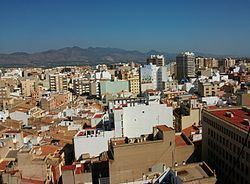Elevation 30 m (100 ft) Local time Monday 8:24 AM | Judicial district Castelló de la Plana Highest elevation 609 m (1,998 ft) Population 173,841 (2014) | |
 | ||
Weather 15°C, Wind SW at 8 km/h, 65% Humidity | ||
Castellón de la Plana ([kasteˈʎon de la ˈplana]), Castelló de la Plana ([kasteˈʎo ðe la ˈplana]), or simply Castellón / Castelló, is the capital city of the province of Castellón, in the Valencian Community, Spain, in the east of the Iberian Peninsula, on the Costa del Azahar by the Mediterranean Sea. The mountain range known as Desert de les Palmes rises inland north of the town.
Contents
- Map of CastellC3B3n de la Plana CastellC3B3n Spain
- History
- Main sights
- Events
- Sports
- Twin towns
- Notable people
- Climate
- Transport
- References
Map of Castell%C3%B3n de la Plana, Castell%C3%B3n, Spain
The Prime Meridian crosses Castellón de la Plana.
History
The first known building in the area was the Moorish castle of Fadrell, near the Alqueries de La Plana. The town proper was officially founded in 1251, after the conquest of the Moorish Kingdom of Valencia by King James I of Aragon in 1233. James granted royal permission to move the town from the mountain to the plain on September 8, 1251, and tradition claims that the move was completed by the third Sunday of Lent, 1252. During the Middle Ages, the city was protected by moats, walls and towers, and a church was built, later becoming a cathedral. In the 16th century the town was one of the last strongholds in the Revolta de les Germanies (local guilds). It also supported Archduke Charles of Austria in the War of the Spanish Succession (1701–14), but was later taken by the troops of Philip d'Anjou.
In the 19th century, the city walls were torn down and it slowly began to expand, a process interrupted by the War of Independence against Napoleon (1804–14) and the Carlist Wars (1833–63). In 1833 Castelló became the capital of the newly constituted province. In the second half of the 19th century, the city again began to expand, marked by the arrival of the railway, the enlargement of the port and the construction of representative buildings (Provincial Hospital, Casino, Theater) and parks.
In 1991 a university (Jaume I University) was established, set upon a modern campus. The local economy is based on industry, tourism and craft-work.
Main sights
Most of the historical buildings are located in the diminutive old town, around the Plaça Major (Main Square). These include:
Events
The annual festivities in Castellon are a week of celebrations three weeks before Easter every year called La Magdalena. People come from all over the province and many international bands and groups participate.
The city is notorious for its music festivals, among which we find: early in February the Tanned Tin music festival for alternative music and experimental music, in July the Festival Internacional de Benicàssim (also known as FIB, which translates to Benicàssim's International Festival), at the beginning of August there is the Arenal Sound and during the middle of that same month, we can find the Rototom Sunsplash Festival, known for its reggae music.
Sports
The city has its professional basketball team AB Castelló, which plays in the LEB Oro.
Twin towns
Notable people
Climate
The Köppen Climate Classification subtype for this climate is "BSk" (Tropical and Subtropical Steppe Climate).
Transport
The small Castellón Airport offers charter and general aviation services, as well as scheduled passenger services to Bristol and London. The new Castellón-Costa Azahar Airport is designed to support large international jet flights and was completed in 2011. As of 2014, it has never been operational due to lack both of interest by any airline and of government certification. It has become a symbol of the wasteful spending prior to the 2008–13 Spanish financial crisis. Valencia Airport is about 70 km (43 mi) south whilst Alicante Airport is another 185 km (115 mi) further down the coast.
The city is served by the Castellón de la Plana railway station. The Euromed railway line links Alicante to Barcelona.
Nowadays, this city has a new public transport called TRAM de Castellón which is a trolleybus. There is just a line Línea 1 (TRAM de Castellón), but authorities are planning to build the second line.
